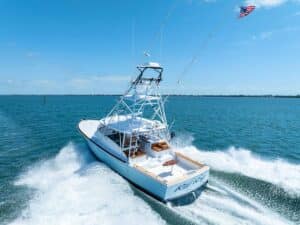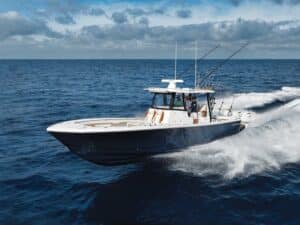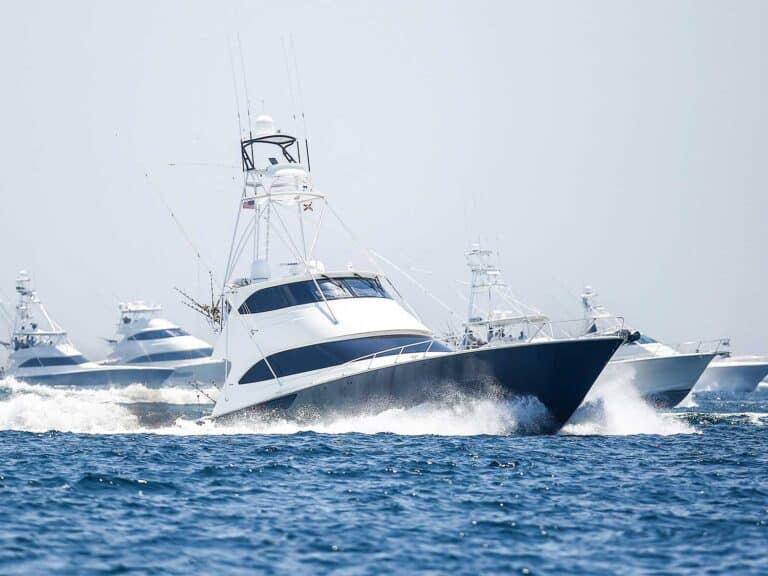
bottom paint
A friend who has a boatyard was talking about the advantages of using some of the newer-technology bottom paints on the market. As a facility owner, he is constantly under the scrutiny of regulating bodies that mandate criteria for his handling of bottom-coating waste and debris.
Some of these newer products are cleaner to apply, and there is less slough and particulates from sanding and prepping for the fresh coat, which means he has less to contain and prepare for proper removal from his facility. He has also noticed that his customers have a longer cycle between bottom cleanings, and they have expressed their approval. A satisfied customer always makes life more pleasant — for both parties.
With the EPA-mandated demand for more environmentally friendly bottom paints, companies are utilizing the latest science to develop “green,” eco-friendly coatings that are capable of keeping the boat from fouling. These formulas typically are water-based and have low or no biocides or volatile organic compounds (VOCs), low or no ablative release during use, which is the sloughing off of the paint in layers as it wears off and uncovers fresh antifoul. For the environmentally inclined, these are big things, and they certainly help the condition of our seas and environment over time.
Almost every manufacturer has its “green” brand of antifouling paint; finding the one that is right for your boat is as easy as doing a nominal amount of research. The problem with all this “green” technology is that there is no standard or classification as to what makes any particular bottom paint “green.” Is it low in VOCs, water-based, containing no or low copper, or biocide-free?
Basically, it’s whatever you consider to be the most important factor to being environmentally safe, as most paints today are much more “green” than in the past. Also, there is a lot of “green washing” in all industries today. The term refers to claims that products are environmentally safe when in fact they may not be totally safe. In the case of antifoul, it is paint and needs to do its job; it has to have some protective quality or it would be useless.
It used to be that you walked into the marine store and bought the heaviest paint you could find because it had more heavy metal in it, which meant you would have better protection. That just does not hold true today, because virtually every manufacturer has reduced the amount of metals and biocides dramatically.
Probably the most important thing to consider if you are going to make a change to a “green” antifoul is compatibility with your old paint; at least understand that you may have an initial increased cost with the preparation and possible application of a tie-coat primer to facilitate a good bond with a clean and smooth surface. Once you have done the proper prep and applied the new paint, you can continue to utilize it for years, provided that you comply with the manufacturer’s application-and-use criteria.
For example, Pettit has developed what they call Clean Core Technology, which has resulted in several cleaner, “greener” scenarios. Their new technology is based on years of research on paint production. They wanted to produce an enhanced paint film, containing fewer heavy metals and allowing for a more consistent release of biocides for either ablative or nonablative paints.
Their Low Density Copper Technology reduces the amount of cupreous oxide, which is replaced with natural silica that provides solid protection while minimizing the amount of copper sloughed off into the water. White Copper (used in their Vivid paints) is a lightweight antifoul that has replaced the heavy red copper of previous paints and requires 50 percent less biocide.
Pettit’s water-based ablative replaces the harsh chemical solvents found in traditional bottom paints with water, creating a low-VOC formula that cleans up with soap and water and offers reliable antifoul protection. Perhaps the most compelling technology for Pettit is found in their Econea product. This is a nonmetallic biocide that is noncorrosive and safe to use on underwater running gear and aluminum. It also has low toxicity and is completely biodegradable.
Another company with interesting technology is Luritek, with their Eco-Clad brand of biofilm paints. Much like fish has slime that repels marine growth, Eco-Clad works with the environment and promotes the growth of a living biofilm. It is unique in that it contains some copper; the copper is elemental copper (like copper pipes that deliver drinking water) and not cupreous oxide or copper thiocyanate, both of which are toxic. Eco-Clad emits a low level of copper — less than 10 mcg per square centimeter per day — which is lower than conventional antifouling paints and lower than international limits established for copper leach. Eco-Clad is biocide-free and is available in VOC-free and low-VOC versions.
A longtime innovator and technology-driven company, Interlux has launched their own environmental campaign, the Echo Program, which focuses on reducing their impact, as a company, on the environment. The Echo Program covers everything Interlux does, from reducing VOCs and biocides to reducing emissions and waste in all their manufacturing and warehouse facilities.
They also have several “green” offerings, including their own Econea product, Pacifica Plus, which is a copper-free dual biocide that does not stain at the water line, because there is no copper in it. The very popular Micron Technology with Biolux series of paints includes Micron 66, a self-polishing copolymer. Micron Extra utilizes less copper more efficiently; Micron Extra VOC is highly engineered to control slime and polishing rate; and Micron CSC and Micron CSC HS are designed to wear away at a controlled rate. Interlux Ultra is engineered for high-fouling areas and is a fast-drying paint for same-day paint-and-launch scenarios.
More than 40 years ago, Flexdel Corp. developed the first completely water-based copolymer ablative paint, Aquagard. Today, Aquagard goes beyond compliance with EPA standards for VOCs and has become a player in the environmentally friendly bottom-paint market. Aquagard utilizes cupreous oxide as its biocide but has developed technology to control leach-out rates. Aquagard requires less copper, but offers year-round antifoul protection. Being water-based, it is easily rolled or brushed and flows out evenly for a smooth finish. It can be applied directly over other hard bottom paints, and it will not streak from rainwater. It cleans up with soap and water, and, with its low VOCs, can be applied indoors in the off-season.
There are plenty of environmentally friendly choices for your application and region of boating; with just a little research, you can help reduce waste in our waterways and prevent growth on your hull bottom for more efficient boating.
**
Some products to make your vessel clean and green:**
Aquagard
www.aquagardboatpaint.com
Water-based with low VOCs
Eco-Clad
www.ecoclad.com
Low copper levels and biocide-free
Interlux
www.yachtpaint.com
Copper-free and slime-blocking technology
Pettit
www.pettitpaint.com
Low toxicity and completely biodegradable







